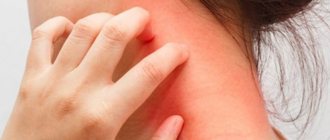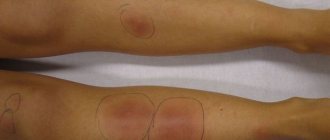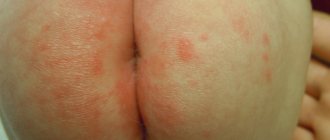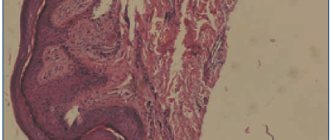Dermatovenerologist
Khasanova
Alina Rashidovna
9 years experience
Make an appointment
Ring-shaped erythema is a multiform lesion of the skin, a characteristic feature of which is the appearance of ring-shaped spots and rashes on the skin. The skin color of the affected areas changes and becomes red, bright pink or bluish. Depending on the causes of the disease, swelling, local fever and other manifestations of the disease may be observed. Changes in skin color occur due to the expansion of the lumen of the blood capillaries penetrating the connective tissue and the associated stagnation of blood.
Types of pathology
Doctors distinguish several types of annular erythema, depending on the causes of the disease:
- centrifugal erythema Daria - most often affecting middle-aged men, less often - children and the elderly, related to infectious-allergic manifestations;
- migratory - a disease of an infectious nature that occurs as a result of a tick bite infected with Borrelia;
- rheumatic, or ring-shaped anular erythema is one of the symptoms accompanying rheumatism, characteristic of children and adolescents.
According to external signs, ring erythema can occur:
- in flaky form - with peeling of dead skin along the edges or the entire surface of the spots;
- in vesicular form - with the appearance of small liquid-filled bubbles along the edge or entire surface of the spots;
- in a garland-shaped form - with the easiest flow, which is characterized by pale pink spots, arranged in chains or garlands and disappearing after a few days;
- in a microgarland-shaped form - with small spots, up to 1 cm in diameter, sometimes accompanied by peeling or the formation of bubbles, with a long course.
The medical literature also mentions other, very rare types of annular erythema - telangiectatic, purpuric or indurated.
Erythema Bietta
Lupus erythematosus (centrifugal erythema of Biette) is an autoimmune disease with a predominant lesion of the skin. A gene disorder of immunity occurs in the body, which leads to the destruction of the body's own cells by the immune system. Thus, an inflammatory process occurs in the tissues, with the destruction of the nuclei of their own cells and the appearance of lupus erythematosus cells. Not only the skin is affected, but also the cells of all organs.
An optical characteristic sign of lupus is a rash, mainly on the face, in the area of the cheeks and wings of the nose, pink-red and sometimes bluish in appearance, slightly swollen. However, there is no tissue atrophy.
It may be a harbinger of complex erymatosis, or occur in conjunction with damage to internal organs, with disseminated lupus erythematosus.
Erythema Bietta manifests itself as a rash on the face
Symptoms
The main manifestation of the disease is the appearance on the skin of characteristic rashes in the form of irregular rings with a bright border raised above the surface of the skin. With Dardieu's centrifugal erythema, they appear, as a rule, on areas of the skin usually covered by clothing - on the back, abdomen and chest, and forearms. Ring-shaped erythema after a midge bite is a single spot spreading from the site of infection, and in its final form it can reach 20-25 cm in diameter. The spots may be accompanied by itching or burning. With the rheumatic form of the pathology, there are no unpleasant sensations.
Are you experiencing symptoms of erythema annulare?
Only a doctor can accurately diagnose the disease. Don't delay your consultation - call
Erythema in children
This phenomenon is not at all uncommon and the following symptoms are observed:
- rash in the form of rings protruding above the skin,
- headache,
- fever, swelling,
- The spots can be up to eight centimeters in length and cause itching and flaking.
Ring-shaped erythema in children is characterized by the appearance of red or bright pink spots. Often in the initial phase it is confused with lichen. Optically, these two diseases are similar, but the causes of origin are different, and therefore the treatment is different. Erythema is an allergic reaction, and lichen is a disease caused by a fungus or virus.
Causes of the disease
There are many diseases and conditions that can cause erythema annulare, since it is not an independent disease and always occurs against the background of some pathological process. Skin manifestations most often develop against the background of:
- accumulation of toxins in the body;
- rheumatism;
- fungal, viral or bacterial infections;
- chronic inflammatory diseases;
- dysfunction of the endocrine gland;
- tuberculosis;
- borreliosis;
- reducing the protective function of the immune system;
- allergic reaction;
- cancer;
- helminthic infestation;
- taking certain medications.
In addition, in many cases, Darier's annular erythema occurs for no apparent reason in completely healthy people.
Prevention
Ring-shaped erythema
– the disease is unpleasant, it is difficult to hide it from others. The pathology may not respond to treatment methods proposed by a dermatologist for a long time. However, if the exact cause can be identified, the problem can be successfully eliminated. With an accurate diagnosis and timely treatment, the prognosis is favorable. There are positive dynamics, despite the fact that this is a chronic disease. The disease does not become malignant, but if there is no treatment or non-compliance with medical prescriptions, a secondary infection may occur.
How to prevent the disease?
Ring-shaped erythema will not appear if the foci of disease are sanitized in a timely manner. If an allergy occurs, you should immediately stop exposure to the allergen, if known. Particular attention should be paid to infectious diseases, fungal infections, gastrointestinal disorders, hormonal changes - skin problems often develop against their background.
Diagnostics
When annular erythema appears, diagnosis is based on data from a dermatological examination and anamnesis. The main task of the examination is to determine the cause that caused the pathological changes in the skin. For this, the patient is prescribed:
- analysis of skin scrapings for fungus;
- clinical blood test;
- testing for treponematosis;
- skin biopsy for histological analysis;
- serological blood test;
- allergy tests.
Based on the results obtained, specific studies can be prescribed to determine the condition of certain organs and identify the underlying disease.
What treatment is prescribed for erythema?
A complex of drugs with the following action is selected:
- antihistamines: ointments, creams, gels, tablets that will help eliminate tissue swelling,
- antiviral: drugs aimed at destroying viruses, if any are present in the body, or preventing their appearance, since the body is in a weakened state and the risk of catching the virus is very high,
- anti-infective,
- antiseptics, glucocorticosteroids: drugs and ointments that block further proliferation of T-lymphocytes, which will help cope with external manifestations,
- drugs that will remove toxins from the body,
- anthelmintic drugs, if there are worms in the body: often several courses of treatment are required, and then also prevention,
- antibiotics are prescribed if there is an infection in the body, and with a prolonged increase in body temperature,
- cytostatics: drugs that will suppress the proliferation of genetically modified immune cells, thereby suppressing the manifestation of signs of autoimmune diseases.
Ointment is prescribed to relieve swelling
Treatment
The basic principle of treating annular erythema is to stop the action of the factor that provokes the pathology. Depending on the diagnostic results, the patient may be prescribed oral medications:
- antibiotics, antivirals to treat infections;
- antiallergic and hyposensitizing agents;
- cytostatics;
- anthelminthic drugs;
- glucocorticoids.
In addition, external agents may be useful - antihistamines, steroids or zinc-containing ointments to reduce discomfort and reduce symptoms. For annular erythema, clinical recommendations may include limiting certain foods that cause an allergic reaction: confectionery, mushrooms, nuts, canned food, smoked meats, citrus fruits, etc. You should be prepared for the fact that the treatment process will last several months, as well as the possibility relapses.
Erythema nodosum - symptoms and treatment
Erythema nodosum is an inflammation of the subcutaneous fat, which is accompanied by the appearance of painful, palpable red or purple subcutaneous nodules. Most often they appear on the legs, sometimes in other areas.
This disease is caused by an increased immune response of the body to the pathogen [1][3]. Despite numerous studies of this pathology, the causes of erythema nodosum and the mechanism of its development have not been sufficiently studied. However, there is a theory that the main cause of erythema nodosum may be various infectious diseases.
Table 1. Causes of erythema nodosum.
| Main reasons | Diseases that may cause erythema nodosum | Other |
| — B-hemolytic streptococcus of group A — Tuberculosis bacillus — Chlamydia — Hepatitis B and C — Herpesvirus family — Various fungi — Protozoa — Lymphogranuloma venereum — Psittacosis — Measles — Cat scratch disease — HIV, etc. | — Sarcoidosis — Ulcerative colitis — Regional ileitis — Hodgkin's disease (Hodgkin's lymphoma) — Lymphosarcoma — Leukemia — Rheumatoid arthritis — Behcet's disease — Malignant neoplasms — Chronic hepatitis — Ankylosing spondylitis — Granulomatous mastitis — Takayasu's arteritis — Vogt's disease — Koyanagi — Granuloma Wegener's ematosis - APS syndrome - Systemic lupus erythematosus, etc. | — Taking medications: sulfonamides, bromides, clomiphene, codeine, co-trimoxazole, D-penicillamine, dapsone, diclofenac, dicloxacillin, estrogens, ibuprofen, indomethacin, interleukin-2, etc. — Pregnancy — Jellyfish burns — Smoke inhalation in firefighters and etc. |
Risk factors for the appearance of erythema nodosum include fungal diseases, inflammatory diseases of the gastrointestinal tract, hormonal imbalances, tuberculosis, and taking various medications [2]
An important role is played by provoking factors , such as climate change, transitional seasons, stress, temperature changes (hypothermia), varicose veins of the lower extremities, etc. The disease is seasonal, usually appears in early spring and late autumn, which is due to frequent colds, sore throats, and decreased immunity.
The incidence of erythema nodosum in different countries can vary from 1 to 5 cases per 100,000 population per year [12]. This depends on the prevalence of diseases that can cause erythema nodosum in a particular area. Mostly, erythema nodosum is detected in people 20-30 years old [2][12]. It is at this age that a person first encounters many infections.
Women who have the HLA B8 gene are more susceptible to erythema nodosum, which may confirm the fact of a hereditary predisposition to this disease [4]. HLA (Human Leukocyte Antigen - human leukocyte antigen) is responsible for recognizing foreign cells and activating the immune response to them. When this mechanism is triggered, we see a clinical picture of inflammation, which is caused by the reaction of the immune system.
It is known that HLA B8 is associated with several groups of diseases, including erythema nodosum. And it is so programmed that it occurs more often in women [11]. This is why women get sick much more often than men (about 3-6 times) [12]. If we do not take into account changes in the genome, then erythema nodosum occurs proportionally equally in men and women, since they are equally susceptible to streptococcal infections and other diseases.
Erythema nodosum is more often detected in the European population, particularly in Scandinavia, while it is rarely diagnosed in Asians, since the HLA B8 gene is almost never found in them [11][13].









